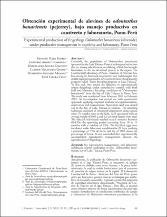Obtención experimental de alevines de odontesthes bonariensis (pejerrey), bajo manejo productivo en cautiverio y laboratorio, Puno-Perú

View/Open
Artículo completo
(application/pdf: 337.4Kb)
(application/pdf: 337.4Kb)
Date
2016-06Author(s)
Yujra Flores, Ernesto
Amaru Chambilla, Glicerio
Segura Zamudio, Marceliano
Villanueva Quispe, Carmen
Siguayro Mamani, Humberto
Chura Cruz, René
Metadata
Show full item recordAbstract
Actualmente, la población de Odontesthes bonariensis (pejerrey)
en el lago Titicaca-Puno, se encuentra en peligro
de extinción debido, entre otros factores, a la pesca indiscriminada,
la cual ha traído limitaciones para el consumo
de proteína de origen animal en la región. El Laboratorio
Continental de Puno - Instituto del Mar del Perú, posee
entre sus funciones, generar nuevas tecnologías que posibiliten
el desarrollo sostenible, regional a partir del programa
de seguridad alimentaria denominado ¨Programa de Cultivo
de Pejerrey en el lago Titicaca¨. Para ello, se planteó
como objetivo obtener de forma experimental alevines bajo
manejo reproductivo en condiciones confinadas de campo
y laboratorio de Odontesthes bonariensis procedentes de la bahía del lago Titicaca en Puno-Perú. El estudio se desarrolló
desde febrero de 2011 hasta febrero 2015. Se realizó una investigación
con enfoque cuantitativo, aplicándose los métodos
empíricos de experimentación, medición y observación. La
captura poblacional se realizó en la bahía del lago Titicaca de
forma aleatoria. La técnica de muestreo consistió en la observación
estructurada mediante red de cerco. Para el trasladado a
condiciones de campo se utilizaron 1235 ejemplares con peso
promedio de 0,66 g y longitud total 6,6 cm. Los individuos
seleccionados alcanzaron una madurez sexual entre el 80-85
%, el periodo de desove ocurrió entre 10-11 meses con una
viabilidad del 95%. Las ovas fecundadas fueron incubadas en
condiciones de laboratorio durante 20 días, alcanzándose un
porcentaje de larvas del 75 % y de alevines del 90 % con respeto
al porcentaje de larvas. Se concluyó que el manejo reproductivo
experimentalmente realizado, permitió la obtención
de alevines. ABSTRACT: Currently, the population of Odontesthes bonariensis
(pejerrey) in the Lake Titicaca-Puno is in danger of extinction
due to, among other factors, overfishing, which has brought
limitations to the use of animal protein in the region. The
Continental Laboratory of Puno - Institute of Peruvian Sea,
has among its functions to generate new technologies that
enable regional sustainable development from a food security
program called “Smelt breeding program at Lake Titicaca”.
To this end, they settled the objective to experimentally
obtain fingerlings under reproductive control, with both
field and laboratory breeding conditions of “Odontesthes
bonariensis” from the bay of Lake Titicaca in Puno, Peru.
The study was conducted from February 2011 to February
2015. An investigation was carried out with quantitative
approach, applying empirical methods of experimentation,
observation and measurement. Population catch was carried
out in the Bay of Lake Titicaca at random. The sampling
technique consisted of structured observation using a purse
seine. To transfer them to the field, 1235 specimens with an
average weight of 0,66 g and 6,6 cm total length were used.
The selected individuals reached sexual maturity between
80-85%, the spawning period occurring from 10 to 11
months with a viability of 95%. The fertilized eggs were
incubated under laboratory conditions for 20 days, reaching
a percentage of 75% of larvae and fry of 90% about the
percentage of larvae. It was concluded that experimentally
accomplished reproductive management, allowed the
reproduction of fingerlings.
Collections
Publisher
Campus
Rights
info:eu-repo/semantics/openAccess







